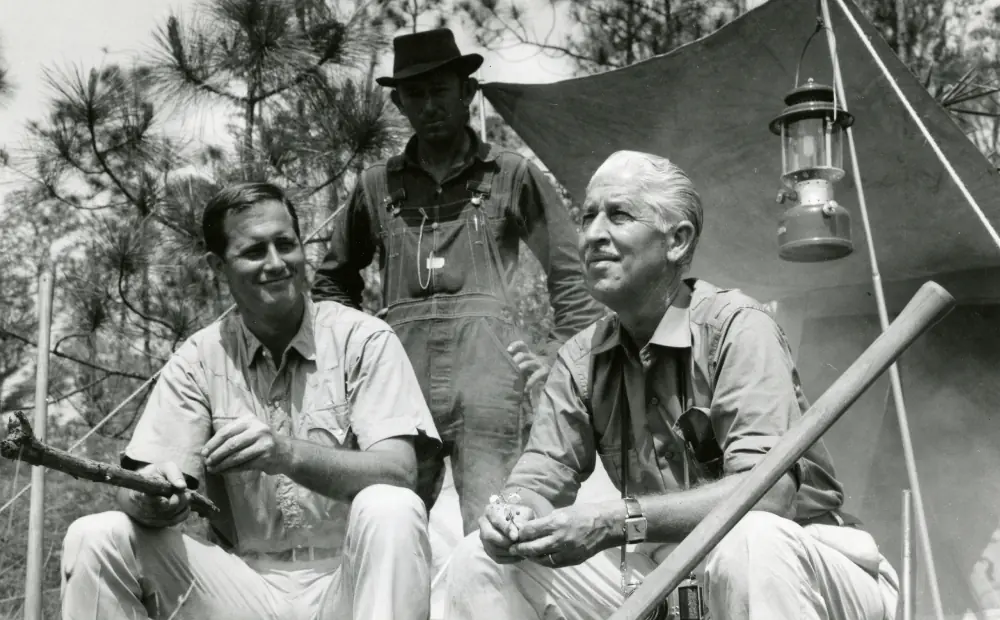0:02
Peter and I are 500 feet above the Coral Sea off the northeast coast of Queensland, Australia, and we're approaching the largest living structure on Earth.
0:12
This is such a massive reef, the largest in the world, it can be observed from outer space.
0:18
What we see below us.
0:20
The Great Barrier Reef is actually made-up of 3000 mini reefs, and it is a world Heron site.
0:27
So our children will get to come here someday, hopefully experience what we are now.
0:32
And there's a lot of conservation work being done to keep this place as attacked as possible.
0:37
And I can obviously see why.
0:40
This is awesome.
0:41
Yeah.
0:45
To get a look at the reef from the surface, we decide to touchdown on the tiny sand island.
0:51
Fragile landforms like this shift, shrink or even vanish with the tide.
0:56
Oh, is this where we're going, baby?
0:58
I hope so, because we are descending rather quickly.
1:01
OK, we’re going down.
1:02
We're going down.
1:03
We're about to lay it under here.
1:05
There we go.
1:06
Oh, my goodness.
1:09
Whoa.
1:10
Oh, look at that.
1:14
And there is not a footprint in the sand.
1:16
This is so special.
1:27
Oh my gosh.
1:29
Wow, look at this.
1:31
We've been to some remote places, but this really isn't.
1:44
I can't believe I'm back here.
1:45
The first time I ever filmed underwater was the Mutual of Omaha's Wild Kingdom right here on the Great Barrier Reef.
1:57
The exceptional clarity of the Coral Sea of Australia is a great aid to the researchers who enter this unusual marine world.
2:05
Oh, you're returning?
2:07
Yeah.
2:07
Wow.
2:07
Well, do you think that it's changed?
2:09
It looks the same on the surface, but I know it's been challenged below the surface.
2:13
So I can't wait to get underwater again.
2:15
A good look at the reef.
2:16
I can't either.
2:17
So I think we should get off of this tiny sand island before the tide comes in.
2:21
Tide is coming in.
2:22
So let's move out.
2:23
Let's go.
2:26
Today, we'll do more than just admire the Great Barrier Reef from above.
2:31
We are here to meet the devoted conservationists striving to preserve it below the surface.
2:36
Our next stop is a helipad situated approximately 30 miles offshore, providing researchers and tourists access to more reef, a vibrant coral habitat.
2:48
From there, we board a dive boat to meet master reef guide Leia Dawes to get an overview of this remarkable ecosystem.
2:55
We're here at the Great Barrier Reef, 1500 miles long.
3:01
If you were to put all of the reef together, it's about the same size as the country of Italy.
3:05
There's different types of coral reefs around the world.
3:08
This one is a Barrier Reef.
3:09
So barrier reefs are situated on the edge of the continental shelf.
3:14
It acts as a barrier to waves, to wind, to strong tides.
3:20
Tourism provides vital economic support for sustaining the Great Barrier Reef by funding conservation efforts, raising public awareness, and motivating global actions to protect this unique marine ecosystem.
3:33
A lot of people think tourism isn't helpful for the reef, but because of its size, there's actually probably less than 3% of the reef that's visited by tourists.
3:43
I've snorkeled several times in my life, but I have never in my life seen coral.
3:49
Yeah, so this is this is a big day for me for sure.
3:52
Master reef guides like Leia specialize in leading visitors on up close tours of the reef.
3:58
I couldn't wait to get in the water.
4:01
We suit up, board a Zodiac, and plunge into one of the most biodiverse habitats in the world.
4:13
Nearly 600 species of corals shaped the Great Barrier Reef, each with its own unique appearance.
4:21
They share these waters with 1600 species of fish, thirty kinds of whales and dolphins, 6 species of sea turtles, and thousands of mollusks and invertebrates like these quick to hide Christmas tree worms.
4:38
We even spot a giant clam, the largest species of clam on Earth.
4:45
Most of the corals here are hard reef building corals, some shaped like rocks, others like tiny trees.
4:52
We also swim above soft corals that sway with the waves, resembling underwater plants.
5:00
Corals are part animal, part plant, and part mineral.
5:05
Tiny tentacled animals called coral polyps catch food drifting in the water.
5:11
Inside the polyps live algae, which create additional food from sunlight and give corals their beautiful colors.
5:19
And to protect itself, the polyp secrets a hard calcium carbonate skeleton.
5:24
As millions of polyps build their skeletons on top of each other, these colonies create the large structures we call coral reefs.












